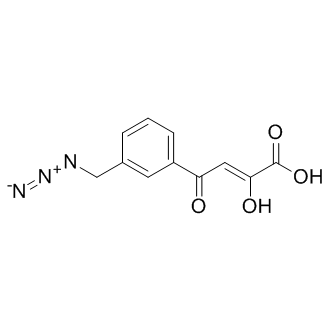| Reference | <p style=/line-height:25px/>
<br>[1]. Hobaika, Z.; Zargarian, L.; Maroun, R. G.; Mauffret, O.; Burke, T. R., Jr.; Fermandjian, S. HIV-1 Integrase and Virus and Cell DNAs: Complex Formation and Perturbation by Inhibitors of Integration. Neurochemical Research (2010), 35(6), 888-893.
Abstract
HIV-1 integrase (IN) catalyzes integration of viral DNA into cell DNA through 3/’-processing of viral DNA and strand transfer reactions. To learn on binding of IN to DNAs and IN inhibition we applied spectroscopy (circular dichroism, fluorescence) in a simplified model consisting in a peptide analogue (K156) of alpha4 helix involved in recognition of viral and cell DNA; an oligonucleotide corresponding to the U5/’ LTR DNA end; and an inhibitor (TB11) of the diketo acid (DKA) family. Results extrapolated to IN show that: the enzyme binds viral DNA with high affinity and specificity, but cell DNA with low affinity and specificity; the affinity of TB11 for IN is high enough to impair the binding of IN to cell DNA, but not to viral DNA. This explains why TB11 is an inhibitor of strand transfer but not of 3/’-processing. These results can help in the search of new IN inhibitors.
<br>[2]. Loizidou, Eriketi Z.; Zeinalipour-Yazdi, Constantinos D.; Christofides, Tasos; Kostrikis, Leondios G. Analysis of binding parameters of HIV-1 integrase inhibitors: Correlates of drug inhibition and resistance. Bioorganic & Medicinal Chemistry (2009), 17(13), 4806-4818.
Abstract
This study undertook an exploratory data analysis of the binding parameters of HIV-1 integrase inhibitors. The study group involved inhibitors in preclinical development from the diketo acid, pyrroloquinoline and naphthyridine carboxamide families and the most advanced inhibitors Raltegravir and Elvitegravir. Distinct differences were observed in the energetics of binding between the studied classes of inhibitors that also correlated with drug resistant patterns. Quantitative-property-activity-relationships correlated experimental IC(50) values to the binding energy and the logarithm of the partition coefficient between n-octanol and water (clogP). The approach followed here serves as an improved basis for the development of /’second generation/’ integrase inhibitors.
<br>[3]. Kawasuji T.Carbamoyl Pyridone HIV-1 Integrase Inhibitors. 1. Molecular Design and Establishment of an Advanced Two-Metal Binding Pharmacophore.J Med Chem. 2012 Sep 10.
Abstract
Our group has focused on expanding the scope of a two-metal binding pharmacophore concept to explore HIV-1 integrase inhibitors through medicinal chemistry efforts to design novel scaffolds which allow for improvement of pharmacokinetic (PK) and resistance profiles. A novel chelating scaffold was rationally designed to effectively coordinate two magnesium cofactors, and to extend an aromatic group into an optimal hydrophobic pharmacophore space. The new chemotype, consisting of a carbamoyl pyridone core unit, shows high inhibitory potency in both enzymatic and antiviral assay formats with low nM IC50 and encouraging potency shift effects the presence of relevant serum proteins. The new inhibitor design displayed a remarkable PK profile suggestive of once daily dosing without the need for a PK booster as demonstrated by robust drug concentrations at 24 hours after oral dosing in rats, dogs and cynomolgus monkeys.
<br>[4]. Yan A, Xuan S, Hu X.Classification of Active and Weakly Active ST Inhibitors of HIV-1 Integrase Using a Support Vector Machine.Comb Chem High Throughput Screen. 2012 Aug 28.
Abstract
Using a support vector machine (SVM), two computational models were built to predict whether a compound is an active or weakly active strand transfer (ST) inhibitor based on a dataset of 1257 ST inhibitors of HIV-1 integrase. The model built with MACCS fingerprints gave a prediction accuracy of 91.82% and a Matthews Correlation Coeffiient (MCC) of 0.73 on test set, and the model built with 40 MOE descriptors gave a prediction accuracy of 93.64% and an MCC of 0.79 on test set. Some molecular properties such as electrostatic properties, van der Waals surface area, hydrogen bond properties and the number of fluorine atoms are important factors influencing the interactions between the inhibitor and the integrase. Some scaffolds like β-diketo acid and its derivatives, naphthyridine carboxamide or the isosteric of it and pyrimidionones may play crucial rule to the activity of the HIV-1 integrase inhibitors.
<br>[5]. Yu S, Zhao G.Development of Polyphenols as HIV-1 Integrase Inhibitors: A Summary and Perspective.Curr Med Chem. 2012 Aug 27.
Abstract
Raltegravir, the only drug targeting the integration step in HIV-1 life cycle, makes β-ketoenol integrase (IN) strand transfer inhibitor (STI) gain a definitive place in the treatment of HIV-1 infection. However, the emergence of viral strains resistant to β-ketoenol STI demands a continued effort toward the discovery of novel IN inhibitors interfering with HIV-1 IN in a mechanistically different manner. Polyphenols, among the most developed IN inhibitors, exhibit a different mechanism of action compared with β-ketoenol STI. Some of them exhibit strong IN inhibitory activity and anti-viral activity at nanomolar level and 1,5-DCQA has been in phase II clinical trial in China. It is undoubted that this kind of compounds are attractive candidates for future inhibitor design, as they should be effective against STI resistant viral strains and display synergistic effect when combined with the current existing STI. However, almost all reviews about IN inhibitors have been focused on β-ketoenol STI, while the thorough evolution and general SAR summaries of polyphenols as IN inhibitors had ever been specially discussed. In this review, we provide a comprehensive report of the nearly twenty year/’s development of polyphenols as IN inhibitors: summarizing general structure-activity relationship (SAR) and suggesting the orientation for further research. Compilation of such data will prove beneficial in developing a novel generation of IN inhibitors.
</p>
|

